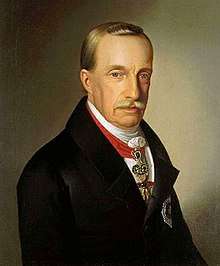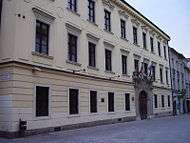Perpetual count
A perpetual count (Hungarian: örökös főispán, Latin: supremus et perpetuus comes)[1] was a head or an ispán of a county in the Kingdom of Hungary whose office was either hereditary or attached to the dignity of a prelate or of a great officer of the realm. The earliest examples of a perpetual ispánate are from the 12th century, but the institution flourished between the 15th and 18th centuries. Although all administrative functions of the office were abolished in 1870, the title itself was preserved until the general abolition of noble titles in Hungary in 1946.
List of perpetual ispánates
Ex officio ispánates

Archduke Joseph of Austria, palatine of Hungary, perpetual count of Pest and Pilis Counties
| County | Perpetual count | Period | Notes | Source |
|---|---|---|---|---|
| Baranya | Bishop of Pécs | ?–1777 | [2] | |
| Bács | Archbishop of Kalocsa | ?–1776 | [2] | |
| Bihar | Bishop of Várad | 1466–1776 | [2] | |
| Esztergom | Archbishop of Esztergom | 1270–1300 1301–1881 |
granted to archbishop Philip Türje by King Stephen V King Andrew III temporarily deprived the archbishop from the ispánate castellans of the archbishops' castle at Esztergom sometimes styled themselves ispán |
[2][3][4] |
| Fehér | Voivode of Transylvania | |||
| Győr | Bishop of Győr | 1453–1783 | [2][5] | |
| Heves | Bishop (from 1804 Archbishop) of Eger | 1498–1840 | [2] | |
| Nyitra | Bishop of Nyitra | ?–1777 | [2][6] | |
| Outer Szolnok | Bishop (from 1804 Archbishop) of Eger | 1569–1840 | [2] | |
| Pest | Palatine | ?–1848 | [2][7] | |
| Pilis | Castellan of the Visegrád Castle | ?–? | [7] | |
| Palatine | 1569–1848 | [2] | ||
| Požega/Pozsega | Bishop of Bosznia | 1753–1770 | renounced of the title | [8] |
| Veszprém | Bishop of Veszprém | 1313–1323 1392–1773 |
although King Charles I awarded the bishops with the ispánate, he seems to have failed to confirm this grant in 1323 the bishops perpetually held the office from 1392 |
[2][9] |
Hereditary ispánates

| County | Family | Period | Notes | Source |
|---|---|---|---|---|
| Abaúj | Perényi | 1570–1598 1643–1699 |
[10] | |
| Csáky | 1702–1764 | |||
| Árva | Thurzó | 1585–1626 | also perpetual ispáns of Szepes County | [11] |
| Thököly | 1666–1668 | |||
| Bereg | Schönborn | 1740– | last grant of a perpetual ispánate | [12] |
| Beszterce | Hunyadi | 1452–1458 | earliest example of a hereditary title in Hungary proper | [13] |
| Beszterce | Szilágyi | 1458–? | [14] | |
| Hont | Koháry | 1711–1826 | [15] | |
| Komárom | Nádasdy | 1751– | last grant of a perpetual ispánate | [16] |
| Liptó | Illésházy | 1582–1838 | also perpetual ispáns of Trencsén County | [17] |
| Požega/Pozsega | Keglevich | 1707–1749 | [18] | |
| Pozsony | Pálffy | 1651– | always a member of the family was appointed ispán from 1580 | [19] |
| Sáros | Rákóczi | 1666–1711 | always a member of the family was appointed ispán from 1622 | [20] |
| Sopron | Esterházy | 1686– | always a member of the family was appointed ispán from 1626 | [21] |
| Szepes | Szapolyai | 1464–1528 | [22][23] | |
| Thurzó | 1531–1635 | also perpetual ispáns of Árva County | [24] | |
| Csáky | 1638– | [25] | ||
| Teočak | Újlaki | 1464–? | in Bosnia | [26] |
| Trencsén | Illésházy | 1600–1838 | also perpetual ispáns of Liptó County | [27] |
| Turóc | Révay | 1712–1875 | always a member of the family was appointed ispán from 1532 | [28] |
| Valkó | Draskovich | 1693–1695 | the county was dissolved in 1695 | [29] |
| Varaždin/Varasd | Erdődy | 1570–c. 1582 | [30] | |
| Erdődy | 1687– | always a member of the family was appointed ispán from 1607 | [29] | |
| Vass | Batthyány | 1728– | [31] | |
| Zala | Althann | 1721–1824 | [32] |
See also
Footnotes
- ↑ Nemes 1989, p. 81.
- 1 2 3 4 5 6 7 8 9 10 11 Fallenbüchl 1994, p. 9.
- ↑ Zsoldos 2011, p. 149.
- ↑ Engel 1996, p. 126.
- ↑ Engel 1996, p. 132.
- ↑ Engel 1996, p. 159.
- 1 2 Engel 1996, p. 163.
- ↑ Fallenbüchl 1994, pp. 11., 130.
- ↑ Engel 1996, p. 231.
- ↑ Fallenbüchl 1994, pp. 10., 99.
- ↑ Fallenbüchl 1994, pp. 10., 61.
- ↑ Fallenbüchl 1994, pp. 10., 66.
- ↑ Engel 2001, p. 293.
- ↑ Pannon Reneszánsz : A Hunyadiak és a Jagelló-kor (1437–1526). Encyclopaedia Humana Hungarica. 4. Retrieved 20 April 2018.
- ↑ Fallenbüchl 1994, pp. 10., 82.
- ↑ Fallenbüchl 1994, pp. 10., 83.
- ↑ Fallenbüchl 1994, pp. 10., 84.
- ↑ Fallenbüchl 1994, pp. 11., 129-130.
- ↑ Fallenbüchl 1994, pp. 10., 92-93.
- ↑ Fallenbüchl 1994, pp. 10., 93-94.
- ↑ Fallenbüchl 1994, pp. 10., 96.
- ↑ Engel 2001, p. 311.
- ↑ Fallenbüchl 1994, p. 99.
- ↑ Fallenbüchl 1994, pp. 9-10., 99.
- ↑ Fallenbüchl 1994, pp. 9., 99.
- ↑ Engel 2001, p. 312.
- ↑ Fallenbüchl 1994, pp. 10., 103.
- ↑ Fallenbüchl 1994, pp. 9., 104.
- 1 2 Fallenbüchl 1994, pp. 11., 132.
- ↑ Fallenbüchl 1994, p. 132.
- ↑ Fallenbüchl 1994, pp. 10., 107-108.
- ↑ Fallenbüchl 1994, pp. 10., 111.
References
- (in Hungarian) Engel, Pál (1996). Magyarország világi archontológiája, 1301–1457, I. ("Secular Archontology of Hungary, 1301–1457, Volume I"). História, MTA Történettudományi Intézete. Budapest. ISBN 963-8312-44-0.
- Engel, Pál (2001). The Realm of St Stephen: A History of Medieval Hungary, 895-1526. I.B. Tauris Publishers. ISBN 1-86064-061-3.
- (in Hungarian) (in German) Fallenbüchl, Zoltán (1994). Magyarország főispánjai, 1526–1848 ("Lord-Lieutenants of Counties in Hungary, 1526–1848"). Argumentum Kiadó. ISBN 963-7719-81-4.
- (in Hungarian) Nemes, Lajos (1989). Entry örökös főispán in: Bán, Péter; Magyar történelmi fogalomtár, I. kötet: L–Zs [=Thesaurus of Terms of Hungarian History, Volume I: L–Zs]. Gondolat. ISBN 963-282-204-8.
- Rady, Martyn (2000). Nobility, Land and Service in Medieval Hungary. Palgrave (in association with School of Slavonic and East European Studies, University College London). ISBN 0-333-80085-0.
- Sedlar, Jean W. (1994). East Central Europe in the Middle Ages, 1000–1500. University of Washington Press. ISBN 0-295-97290-4.
- (in Hungarian) Zsoldos, Attila (2011). Magyarország világi archontológiája, 1000–1301 ("Secular Archontology of Hungary, 1000–1301"). História, MTA Történettudományi Intézete. Budapest. ISBN 978-963-9627-38-3.
This article is issued from
Wikipedia.
The text is licensed under Creative Commons - Attribution - Sharealike.
Additional terms may apply for the media files.